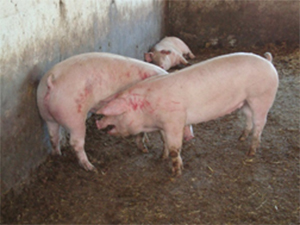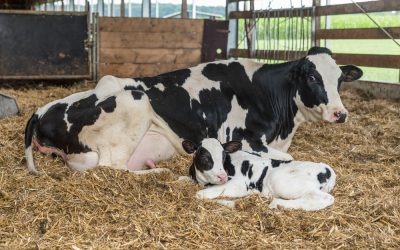P. Llonch, E. Mainau, D. Temple, X. Manteca
More information
Download PDF Technical document
Aggression in pigs occurs as a natural behaviour when stablishing hierarchy after mixing unfamiliar animals. It goes from threats or non-contact aggressive encounters to contact aggressions which can provoke lesions. As mixing may occur several times in pig farming, aggressions can happen in repeated occasions with negative welfare consequences for the pigs such as distress, injuries and sometimes even death. For improving pig welfare, strategies to prevent or reduce aggressions should be implemented in pig farms.
WHY AGGRESSIONS OCCUR IN PIGS?
Pigs are gregarious animals and the social structure is based in the dominant-subordinate relationship to establish hierarchy. The reason behind this social organisation is to establish an order of access to resources when these are limited. The formation of hierarchy is based on the dominance-subordinate relationship and it occurs right after mixing of unfamiliar animals, lasting from 24 to 48 hours. Pigs use aggression to establishes the dominance-subordinate relationship. Therefore, fighting occurs especially during mixing of unfamiliar animals. Scarcity of key resources such as feed, water or space to rest will facilitate competition and fights. For example, when feed is limited, this will be first accessed by dominant pigs and followed by its subordinates.
In a group of pigs, once hierarchy has been established, aggressions will decrease dramatically. However, when the group changes, hierarchy breaks down and the dominant-subordinate relationship needs to be re-established. Mixing pigs is one of the most common situations when the disruption of hierarchy can lead to increased aggressions. In pig farming, aggressions after mixing can occur in several occasions such as weaning piglets, transport to other farms or the slaughterhouse and group conformation of sows during gestation. In any case, the reason behind mixing is to achieve groups of animals as homogenous as possible in age and weight.

Agresión en una postura paralela inversa en cerdas nulíparas al mezclarse.
FACTORS IMPLICATED IN THE PIG AGGRESSION
The degree of aggression in a group of pigs is determined by:
- Individual aggressiveness and temperament: Temperament reflects individual differences in behaviour, which are stable across time and situations. Animals that are more temperamental are more likely to be aggressive. Aggressiveness is a heritable trait and there are genes (NR3C1 and AVPR1B) that have been identified to be associated with this trait.
- Body weight: It influences the perception of an individual of its chances to win a contest. Therefore, heavier animals will be more self-confident and will engage more often in fights. In addition, aggressions are more intense as animals are more similar in body weight.
- Sex: Aggressive behaviour is mediated by endocrine factors associated to sex, making that males are usually more aggressive than females.
Housing conditions may also affect aggressions in pigs. Space is a resource but can also be a facilitator of pig encounters, which can lead to events of aggression. In this sense, both space and density play a key role. High densities enable social interactions between pen mates, both positive and negative, so the total number of aggressions may increase. For instance, some studies suggest that by reducing a 50 per cent the stocking density, aggressions decrease to one third of initial values. In parallel to density, availability of space will also be determinant as bigger areas may help receivers escape from aggressors and reduce the number of negative encounters.
IMPLICATIONS FOR PIG WELFARE
Aggressions are highly distressful for pigs, especially during fight contests where there is a big mobilisation of energy reserves. Distress caused by aggressions causes immunosuppression reducing the capacity to protect against infectious threats and increasing the risk of disease. Weaning is one of the most stressful points of pig’s life, especially because aggressions due to mixing unfamiliar piglets. Research has shown the association between reduction of immunocompetence at weaning with an increase of gastrointestinal diseases such as diarrhoea. Other effects of aggression-induced stress are the reduction of feed intake, and consequently a decreased growth.
Lesions have important consequences for animal welfare, as they are a source of pain. Aggressions, especially in severe fights, may provoke injuries going from mild skin lesions to severe injuries reaching tissues under the skin. An example of this are vulva lesions provoked during aggressions at feeding between group housed gestation sows. In addition to pain, injuries and wounds are a threat for the animal health as it can be infected and lead to diseases such as septicaemia and eventually death. The provision of preventive measures against aggression in pigs may decrease the occurrence of diseases and consequently the use of treatments against disease such as antibiotics and painkillers.
In group-housed gestation sows, aggressions occurring during the first month of pregnancy have been associated with abortions. This is the reason why gestating sows can be crated during four weeks after insemination in some welfare regulations (i.e. European Council Directive 2008/120/EC). After that period though, there are no evidence that sow aggressions have an impact on reproduction performance.
“Fights produce fear, stress and health problems in pigs”
STRATEGIES TO PREVENT PIG AGGRESSION
In piglets, aggression can be prevented at weaning by socialising them during lactation. Early socialisation during the first two weeks after birth improve the social abilities of piglets and reduces the aggressive encounters in future events of mixing. For instance, a study shows that piglets from litters mixed during lactation showed less skin lesions than piglets kept in single litter when mixing at weaning. Another strategy to reduce aggression at weaning is the use of synthetic maternal pheromone. Different studies evidenced that it reduces the number of skin lesions but also the time spent fighting in aggressive encounters.
In group housed gestation sows, aggressions can be prevented by minimising changes in the social structure of the group. However, this cannot always be achieved as oestrus repetitions may provoke changes of sows within groups. Additionally, some farms organise sows in dynamic groups were pens of gestation sows are in constant inflow and outflow. In this case, aggression can be decreased by managing batches of sows instead of single sows. Alternatively, management of resources offers a potential to reduce aggressions as they mostly occur when access to resources (i.e. food) is limited. Gestation sows are usually feed restricted which exacerbates this problem. Evidence has shown that providing feed ad libitum during mixing reduces severe skin lesions, indicating less severe aggressions. On the other hand, electronic feeding stations that allow feeding without being disturbed by the rest of the sows is also an alternative, although more expensive than group feeding systems. The presence of a crated and visible boar closed to sows’ pen can also help to reduce the number of aggressive interactions, likely because the dominant role of the boar over the sows’ group.
Other strategies can be applied in all phases of production in pig farming (e.g. rearing piglets, fattening pigs and gestation sows). For instance, the pen design, which can facilitate aggression receivers hiding or escaping from the aggressor. The presence of barriers in the pen as well as pens having floors at different levels are examples of this strategy.
Other methods can be used in peaks of aggression as for example provision of fresh bedding (e.g. straw). However, although they can be proven effective in some circumstances they are not successful to prevent aggression in the longer term.
SUMMARY
Pigs are social animals that establish dominant-subordinate relationships by means of aggressions. Contact and non-contact aggressions occur predominantly when unfamiliar pigs are mixed and it can be a welfare problem if it triggers distress or causes lesions. The reduction of aggressions will benefit animal welfare by reducing stress and lesions and improve the health status of pigs. The most notable strategies to reduce aggressions are keeping social groups stable, reduce stocking density and facilitate access to resources such as feed.
REFERENCES
- Erhard HW, Mendl M & Ashley DD, 1997. Individual aggressiveness of pigs can be measured and used to reduce aggression after mixing. Applied Animal Behaviour Science, 54, 137-151.
- Camerlink I, Turner SP, Bijma P & Bolhuis JE, 2013. Indirect genetic effects and housing conditions in relation to aggressive behaviour in pigs. PloS one, 8, e65136.
- Turner SP, Roehe R, D’Eath RB, Ison S., Farish M, Jack MC, Lundeheim N, Rydhmer L & Lawrence AB, 2009. Genetic validation of postmixing skin injuries in pigs as an indicator of aggressiveness and the relationship with injuries under more stable social conditions. Journal of Animal Science, 87, 3076-3082.



